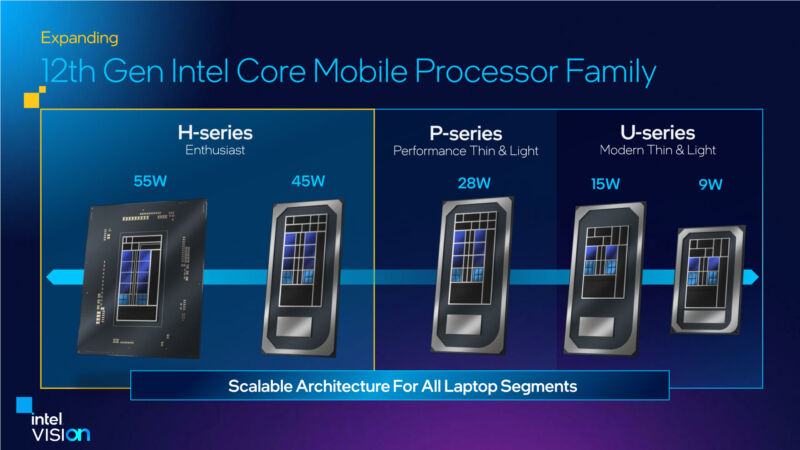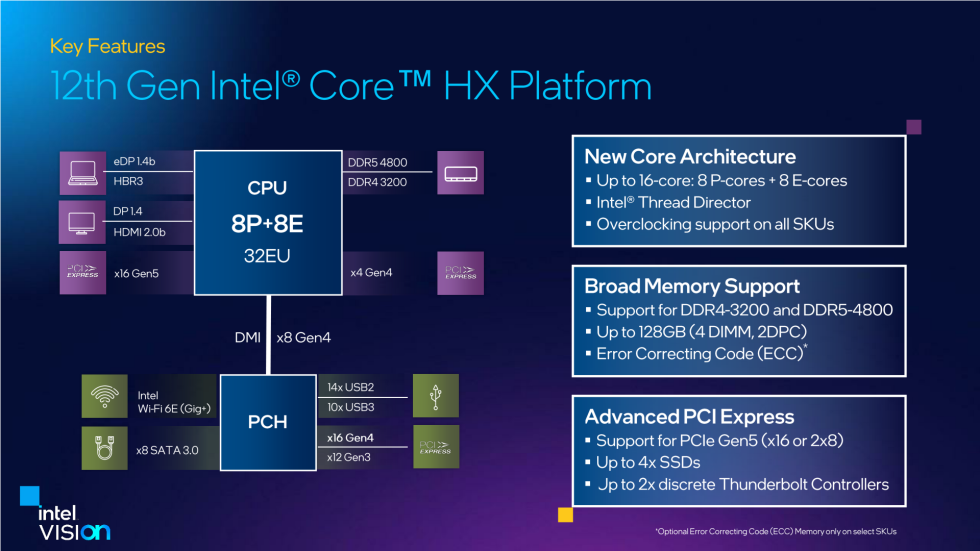
Earlier this year, Intel announced three iterations of its 12th-generation Alder Lake CPU architecture for laptops: the U-series, which covers thin-and-light Ultrabooks, the P-series for thin-and-light workstation laptops, and the H-series for beefier workstations and gaming laptops with more room for large processor fans and heatsinks.
Now, Intel is adding one more series of chips: the HX series, designed for even faster laptops. Despite sharing a letter with the H-series chips, the H and HX CPUs don't have a lot in common. The H-series chips are scaled-up versions of Intel's laptop processors with beefier integrated GPUs, integrated Thunderbolt, and a built-in chipset controller on the same package as the rest of the CPU. The HX chips, on the other hand, use the same dies as Intel's desktop Alder Lake chips but are soldered to a laptop's motherboard rather than inserted into a CPU socket.
| CPU | P- and E-cores | P-core clocks (Boost) | Base TDP | Turbo TDP |
|---|---|---|---|---|
| Core i5-12450HX | 4P/4E | 2.4 GHz (4.4 GHz) | 55 W | 157 W |
| Core i5-12600HX (vPro) | 4P/8E | 2.5 GHz (4.6 GHz) | 55 W | 157 W |
| Core i7-12650HX | 6P/8E | 2.0 GHz (4.7 GHz) | 55 W | 157 W |
| Core i7-12800HX | 8P/8E | 2.0 GHz (4.8 GHz) | 55 W | 157 W |
| Core i7-12850HX (vPro) | 8P/8E | 2.1 GHz (4.8 GHz) | 55 W | 157 W |
| Core i9-12900HX | 8P/8E | 2.3 GHz (5.0 GHz) | 55 W | 157 W |
| Core i9-12950HX (vPro) | 8P/8E | 2.3 GHz (5.0 GHz) | 55 W | 157 W |
These CPUs have higher TDPs than their H-series counterparts, with 55 W base TDPs instead of 45 W and 157 W Turbo TDPs rather than the 95 to 115 W TDPs of the H series. The power increase means these chips will run faster for longer than H-series processors at the expense of higher power consumption and heat output. However, our testing of these desktop chips suggests that the Core i7 and i9 processors will benefit more from the boosted power limits than the lower-core-count Core i5 versions.
Being a scaled-down and repackaged desktop chip offers some benefits and drawbacks compared to regular H-series laptop processors. On the positive side, the Core i7 and Core i9 chips offer an additional pair of P-cores and eight efficiency cores, for 16 cores and 24 threads. As long as your laptop can handle the extra power requirements, these should be helpful for CPU-heavy productivity and rendering tasks.
These processors also support PCI Express 5.0, though there's not much of a point to it yet—current GPUs and SSDs don't use the new standard yet, and won't for a while. They also support memory overclocking, the same as their desktop counterparts, and the vPro-compatible versions support ECC memory as well.

Whether the drawbacks bother you will depend on what you're doing. The chips' integrated GPUs top out at 32 execution units (EUs), down from a maximum of 96 in the H-series CPUs. Laptops with HX processors are near-certain to include dedicated GPUs, which usually won't be a big deal, but the CPUs' lack of integrated Thunderbolt 4 connectivity is more glaring. Up to two dedicated Thunderbolt controllers can be added, but that increases cost and complexity.
The Core i7 and i9 HX-series chips could make some sense for people who need all the CPU performance they can get in a laptop, but the oddball Core i5 HX offerings are probably best avoided. They include just four P-cores and either four or eight E-cores, no more than the regular H-series chips, and at these core counts, they're unlikely to benefit much from their boosted TDPs.
Intel didn't give a specific availability date for laptops with HX-series CPUs but said that "more than 10 workstation and gaming designs" would be coming from the PC companies "this year."
Listing image by Intel
reader comments
53